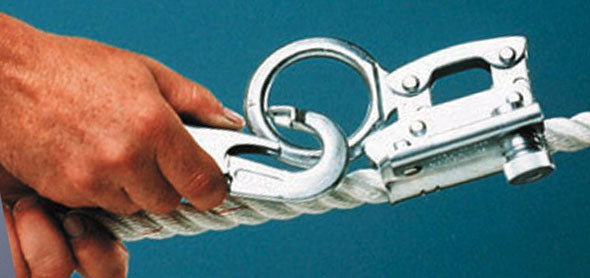A couple of months ago we talked about how a vertical lifeline works, but we really didn't address one of the most important components of these systems. The Rope Grab.
The rope grab is the device that allows the worker to move up and down a vertical lifeline. It's like a bus pass. Without it, you're an idiot with a rope tied around your waist. (Not a good idea!)
One of the first things to consider while using a rope grab is to find where your rope meets the roof edge and tie a knot. This is just an added safety precaution you can make in case the unforeseeable happens.
Now, there are three different types of rope grabs available out there, and they all work mostly the same, but there are some slight variations to talk about.
1. The manual rope grab is basically a metal hand trigger. When you hold the rope grab down, you are able to move freely up and down the rope. Once you let go, the rope grab latches to the rope and will no longer move up and down. This way you won't fall any further. If you do fall, do not grab onto the rope grab and pull the trigger! You'll just keep sliding down the rope, which is not good. This would be one of the reasons you would want to tie that knot in the end of your lifeline.
2. The second type of rope grab is called a trailing rope grab. This rope grab is a little more convenient because the rope grab will move up and down the lifeline by itself. You don't have to squeeze the trigger, and as long as you move slowly the grab will move by itself. If you jerk on the rope grab or fall, the rope grab locks into place and keeps you from falling further.
3. The final type of rope grab is manufactured by Super Anchor and uses a fancy pants knot to do what the trailing rope grab does without all of the metal components. This means that the unit remains light and uses time-tested ancient physics to lock around the rope in case of a fall. It's a pretty neat piece of machinery.
Hopefully, that explains a little better how a rope grab actually works. If you need help picking one out or have some more questions, be sure to let us know.




